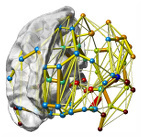The rise of the circuit-based human
 I’ve got a piece in The Observer about how we’re moving towards viewing the brain as a series of modifiable brain circuits each responsible for distinct aspects of experience and behaviour.
I’ve got a piece in The Observer about how we’re moving towards viewing the brain as a series of modifiable brain circuits each responsible for distinct aspects of experience and behaviour.
The ‘brain circuit’ aspect is not new but the fact that neuroscience and medicine, on the billion-dollar global level, are reorienting themselves to focus on identifying and, crucially, altering brain circuits is a significant change we’ve seen only recently.
What many people don’t realise, is the extent to which direct stimulation of brain circuits by implanted electrodes is already happening.
Perhaps more surprising for some is the explosion in deep brain stimulation procedures, where electrodes are implanted in the brains of patients to alter electronically the activity in specific neural circuits. Medtronic, just one of the manufacturers of these devices, claims that its stimulators have been used in more than 100,000 patients. Most of these involve well-tested and validated treatments for Parkinson’s disease, but increasingly they are being trialled for a wider range of problems. Recent studies have examined direct brain stimulation for treating pain, epilepsy, eating disorders, addiction, controlling aggression, enhancing memory and for intervening in a range of other behavioural problems.
More on how we are increasingly focussed on hacking our circuits in the rest of the article.
Link to ‘Changing brains: why neuroscience is ending the Prozac era’.


Tom Stafford's Blog
- Tom Stafford's profile
- 13 followers



